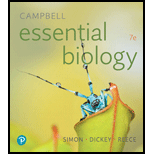
Concept explainers
Place these levels of classification in order from least inclusive to most inclusive: class, domain, family, genus, kingdom, order, phylum, species.
To determine:
The correct order of classification levels from least inclusive to most inclusive: class, domain, family, genus, kingdom, order, phylum, and species.
Introduction:
Carolus Linnaeus proposed a scheme which became the basis for the taxonomy. Taxonomy is that branch of science which is used for the identification, naming, and classification of an animal. A hierarchy level is followed to classify animal. The hierarchy order of classification is: Kingdom, phylum, class, order, family, genus and species.
Explanation of Solution
Taxonomy helps in the classification of least inclusive groups into increasing wide categories. The order of least inclusive to most exclusive group is as follows:
- Species
- Genus
- Family
- Order
- Class
- Phylum
- Kingdom
Species is the least inclusive classification level as more than one species is included in a genus. For example, the genus Panthera consist three species the lion, tiger and jaguar. A genus is included in the family; families are put into orders, orders into different classes, classes into various phyla and different phyla into kingdom. Kingdom is the most inclusive level of classification as it includes various animal phyla.
The taxonomic classification is done by placing animals into systematic and broader category that has helped in clear understanding of different organisms and the world around us.
Want to see more full solutions like this?
Chapter 13 Solutions
Campbell Essential Biology (7th Edition)
- Which level of taxonomic classification will have the the most types of organisms included within it (i.e. the collective largest)? Phylum Domain Kingdom Order Genusarrow_forwardDefine the following term: -taxon (taxa) -operational taxonomic unit (OTU) -morphology -anatomy -flora -fauna -taxonomy -systematics -phylogenyarrow_forwardAt the end of the 19th century, taxonomists adopted the goal of developing a natural system of classification. In a natural system, which kinds of organisms are classified together?arrow_forward
- Which of the following statements is correct about the hierarchy of the taxonomic system currently used to classify organisms? Many different families of organisms belong to the same order. Many different orders of organisms belong to the same species. Many different classes of organisms belong to the same genus. Many different kingdoms of organisms belong to the same phylum.arrow_forwardList the three major domains of life and the six kingdoms of organisms. Describe the fundamental criteria used in assigning organisms to these divisions.arrow_forwardList the categories family, order, class, and genus in the order of their inclusiveness, starting with the least inclusive:a. order, class, family, genusb. genus, order, family, classc. genus, family, class, orderd. genus, family, order, classarrow_forward
- Define and differentiate the term phylum,,class,family,order,genus?arrow_forwardPhylogeny refers to the evolutionary descent of taxa. It refers to the relationship between ancestors and descendants and relationships among descendant taxa. It shows the lineage of taxa which can be summarized in a branching diagram called a phylogenetic tree.1. Express some basic evolutionary relationships among groups of microorganisms, plants, and animals; 2. Illustrate the relationship of organisms with their environment; and 3. Analyze environmental factors contributing to biodiversity richness and lossarrow_forwardDirections: For the following organisms below, you are to sort them into at least 4 different groupings. There must be at least 2 organisms in a grouping. You may place them into columns (in a chart of some sort) or simply Number or your groups and list the organism that are included. ALSO, you must include a written description (at least 2 sentences) describing the characteristics of EACH GROUP that apply to all organisms within that group. Hint** A quick google search, or image search may provide you the visual data you need to categorize the organisms. Sponges (Porifera) Cnidarians (Cnidaria) Comb jellies (Ctenophora) Flatworms (Platyhelminthes) Ribbon worms (Nemertea) Nematodes (Nematoda) Arrow worms (Chaetognatha) Segmented worms (Annelida) Sipunculans (Sipuncula) Molluscs (Mollusca) Arthropods (Arthropoda) Bryozoans (Bryozoa) Phoronids (Phoronida) Lamp shells (Brachiopoda) Echinoderms (Echinodermata) Hemichordates (Hemichordata) Chordates (Chordata)arrow_forward
 Concepts of BiologyBiologyISBN:9781938168116Author:Samantha Fowler, Rebecca Roush, James WisePublisher:OpenStax College
Concepts of BiologyBiologyISBN:9781938168116Author:Samantha Fowler, Rebecca Roush, James WisePublisher:OpenStax College
